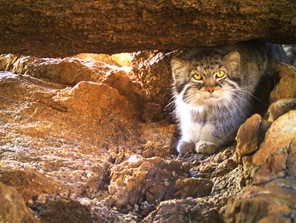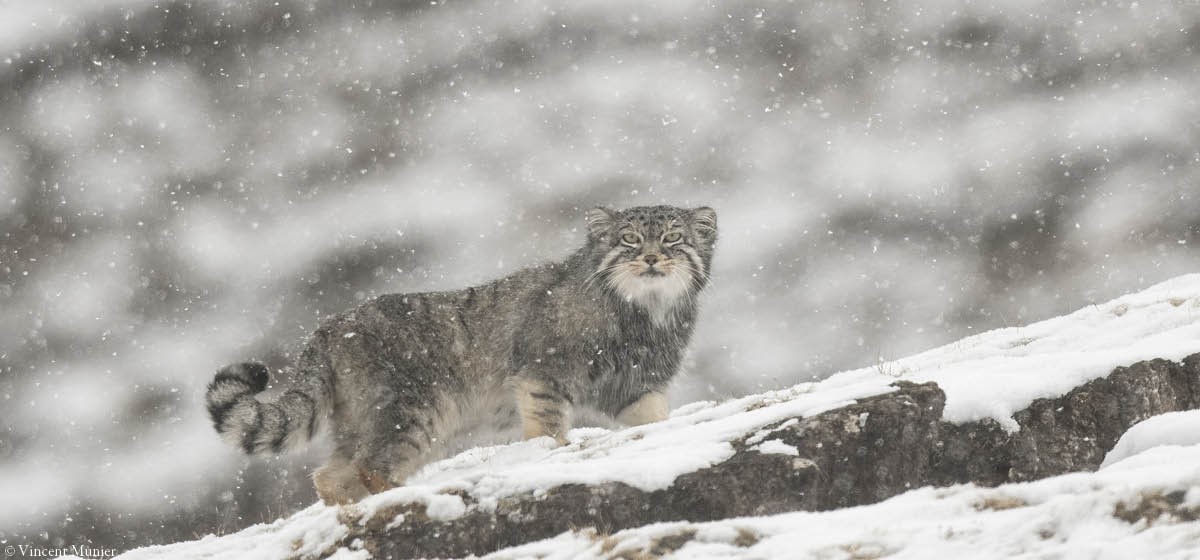Pallas cat
The Pallas's cat (Otocolobus manul) is a small feline that lives among the mountains and grasslands of Central Asia. The species has a large distribution area that includes 16 countries and extends from Iran in the west to China and Mongolia in the east, but its actual occurrence in the distribution area is largely unknown.
The Pallas's cat is not threatened from a global perspective, but many of the populations in the distribution area are small, isolated and declining and the species risks local or regional extinction. The species is threatened by the destruction of its habitats, they are killed by domestic dogs, they get caught in traps intended for other species and their natural prey such as rodents and piphars are poisoned.
The Pallas's cat is one of the world's least studied felines and the lack of knowledge is something that limits the development of targeted conservation measures for the species. To improve our knowledge of the species and at the same time improve the global conservation measures, Pallas’s cat International Conservation Alliance (PICA) was established. PICA is an international collaboration between Nordens Ark, the Royal Zoological Society of Scotland, the Snow Leopard Trust and Fondation Segré.

Pallas's cat. Photo: Wildlife Initiative and the S. Illinois University
What we do at Nordens Ark
PICA's overall goal is to increase the conservation measures for the Pallas's cat within the species' distribution area and at the same time increase the global awareness of the species. PICA works to preserve the Pallas's cat through research, education and strategic planning.
An important part of this work is to promote cooperation between different stakeholders and PICA works closely with Pallas's cat Working Group, IUCN Cat Specialist Group and other researchers and Pallas's cat experts. By working together with this extensive network, PICA has played an important role in the coordination and development of the species' first global conservation strategy.
To support various conservation initiatives in the spreading countries, PICA started the PICA Small Grant Program in 2020. Here, researchers and organizations can annually apply for money for various projects that will increase knowledge about the Pallas's cat and the threats that the species faces. Through PICA, we currently support 11 research and conservation projects in 8 different distribution countries.
An important element in all conservation projects is education and information. If people do not know the species we want to preserve, it is unlikely that they will show interest or support for the conservation project. This is of course extra important in areas where the local population is directly affected, both negatively and positively, by the species we work with. PICA works on several fronts to spread information about the Pallas's cat. The focus is on disseminating knowledge in the countries of distribution but also to zoos around the world. Among other things, we have developed a standardized educational material, translated into several languages, which can be used in several different countries and produced a children's book together with United For Literacy and IUCN Cat Specialist Group
News from the project - January 2025
A record number of new conservation projects for the Pallas’s cat have been granted funding through the PICA Small Grant Program. The funds will support two projects in Mongolia, two in Nepal, and one in China.
Nature knows no borders – a major step forward in protecting the Pallas’s cat
Through a cross-border collaboration between PICA, the governments of Kazakhstan and Uzbekistan, the IUCN SSC Cat Specialist Group, and the Manul Working Group, the Pallas’s cat has now been listed under the Convention on the Conservation of Migratory Species of Wild Animals. This is an incredibly important step in the conservation of the species.
Exciting news from our partner, the Snow Leopard Trust! For the first time ever, a Pallas’s cat has been captured on camera in the Kinnaur region of Himachal Pradesh, India. The cat was detected through images from three camera traps placed during a snow leopard survey at an altitude of 3,900–4,100 meters above sea level.
In collaboration with
Fondation Segré, Snow Leopard Trust och Royal Zoological Society of Scotland.




